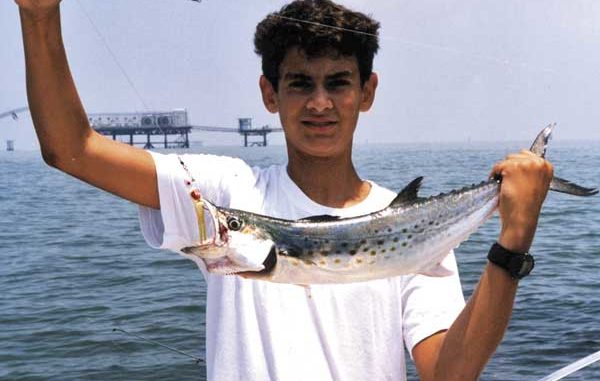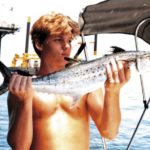
Everyone heads way out to the glamour species this month, but staying close to the shore has definite advantages.
“This don’t count!?” Eddie snarled from the bow of Pelayo’s boat.He lifted his rod high, displaying what was left of his red snapper — mostly head, a little backbone. Eddie had been cranking it up, yelling: “Here’s the limit! Got me a nice one!”
“Freakin’ bluefish!” he now raged. “They tore him up! Ain’t no way I’m counting this in my limit!”
Eddie’s face was crimson, from both fury and sunburn. From our Tigerland days, Eddie well remembered this form of piscine larceny. Half of every bull croaker, white trout or snapper we cranked up from the bottom of the rigs in the 1970s and early ’80s, it seemed, got chomped and shredded by packs of ferocious bluefish. “Gulf piranha” we called them.
But then for years — decades, actually — we’d been mostly free from their depredations. Now came this theft — and at the WD 30s, which are fairly shallow rigs (53 feet) and which, even in those disco days, were relatively free of marauding blues.
For whatever reason, blues seem to be making a comeback, though the croaker and white trout (the mainstay of the old bottom-fishing charter industry) remain scarce.
“Better count him, Eddie,” counseled Chris. “You never know. Just like with duck hunting — you never know when some agent or snitch might be watching us through binoculars. This rig is manned. Might have some spies up there watching us. They might report us to the authorities on the radio. Some agents might be up there themselves just waiting to pounce on us. It ain’t worth it. Things could get outta hand — pepper gas, tasers, billy clubs, maybe even water cannons out here.”
“WHAT?!” Eddie frowned. “Man, now I know you guys have sold out! This ain’t the same gang I used to know at Tigerland! No way!”
“No more snapper,” yelled Pelayo. “Got it?! Chris is right. It just ain’t worth it. Plenty other great fish we can have a blast with. So let’s get at ’em!”
We prefer snapper fishing at shallower rigs (45 to 60 feet) and with shrimp-tipped jigs on medium spinning tackle (same tackle and rigs we use for reds at the rocks). Snapper fishing is more fun this way, and nowadays those minuscule snapper limits are a cinch. The fish we generally catch in these shallow waters won’t be huge; they’ll be right at legal size. But hey — these are the best eating.
Eddie pulled off the mutilated snapper head, tossed it in the greenish water and sat down in a funk.
“Buncha wussies!” he snorted. “Billy clubs never scared us off at the Endymion parade over by Orleans Avenue in 1980! And look!” Eddie jerked off his hat and parted his hair. “I still got the scar!”
Eddie had a point, but he wasn’t the only one with a scar. Disco babes sported long and sharp fingernails and, when scorned, wielded them in a manner to shame the most furious leopard.
A 200-pound bluefish would close every beach from Maine to Key West, I was musing while some ripped into the discarded snapper head. A 500-pounder would make transoceanic shipping unsafe.
Watching a pack of blues shred a red snapper down to the gillplates always triggers such speculation. My initial rage at losing a snapper (or croaker or white trout) always turns to fascination while watching these maniacs in their flesh-ripping frenzy.
Usually, our dance frenzies at Godfather or 41/41 the previous night had been very similar, though we’d been much more colorfully attired.
OK, so the blues had moved in. In the disco days, this meant we’d haul in the rig hook, and take off. Not nowadays — not with today’s pathetically (and utterly unnecessarily) diminutive snapper limits.
Ask any diver about the swarms of snapper around the rigs lately. There’s many more than 20 years ago. At any rate, with today’s gas prices, you’d have to be crazy to haul it out here for a few snapper.
I knew the blues were worked up. They’d start hitting anything we threw at them. In the interest of conservation (conserving what’s in my tackle box, that is) Chris and I sliced 3-inch long, 1-inch wide strips from a hardtail we’d caught earlier, and hooked the very end of the skin to our 3/8-ounce jig heads.
The flapping action as you race this bait across the surface drives bluefish nuts. There’s nothing like watching a pack of them racing after this bait for sheer fun — except what happens when one grabs it (if he beats a Spanish, that is). If it sinks too quickly, a triggerfish might grab it. But hey, we can certainly live with that too. Their snow-white, delectable flesh is right up there with snapper — except it freezes better.
WHAM!!
“Check it out!” Chris whooped from the stern as his pole bent and a blue went berserk on the surface. Five strips of hardtail jack, and a half hour later we closed out with a dozen blues, all between 2 and 4 pounds. An hour of non-stop, spool-sizzling action that no number of specks could ever hope of matching.
Blues are what biologists call “pelagic” fish, which means they live in the “water column,” which means they don’t live or feed near the bottom. Pelagics (mackerels, tunas, etc.) are constantly on the move. You won’t find them holed up in some crevice or curled up against some structure on the bottom.
They’re burning energy 24 hours a day, which means they require more fuel than bottom feeders. That fuel comes mainly from shredding and wolfing down other fish, and blues are almost constantly seeking them.
We were happy to provide them with close facsimiles of their normal fare, and would dine royally at Doc Fontaine’s Venice boathouse (which he lent us while he cavorted at the Cannes Film Festival) as a result.
Ice down bluefish immediately, cut away the dark red layer close to the skin after filleting, deep fry them in chunks until they just float and you’ll see what we mean (for maximum juiciness, don’t overcook them). Leave the skin and scales on a bluefish fillet and grill it skin-side-down while basting it with lemon butter or barbecue sauce (like redfish), and you’re in for another surprise. Again, cook it for a shorter period than a red.
I sent a white sparkle beetle on an arching flight about 80 feet behind the boat, and watched it plop right next to one of the swirls that kept erupting in the murky green water around the rig. I flipped the bail, cranked once and almost had the pole jerked from my hands.
“There he is!” I howled. “Gotta be a Spanish!”
“Or a hardtail,” retorted Pelayo. “Or a bluefish, or a lookdown, or a little tunny, or a jackfish, or ….”
Actually he was right. Cast around a rig in summer with a spoon or jig, and there’s really no telling what’ll grab it. And almost anything that does can strip your spool in seconds, and will prove delectable when freshly fried or grilled.
But I had cast behind the boat into the open water away from the rig. Spanish mackerel don’t hug the pilings like blues and hardtails. They’re more like kings. They like to circle the rig from the outside.
In more than 20 years of diving these rigs, we’ve never seen more than a handful of Spanish actually swimming through the rig. They’re usually streaking about on the outside.
I stood on the bow with the pole over my head just letting the sucker run, savoring every sizzling second.
“Run you maniac!” I screeched.
Ah, a beautiful Saturday morning on the Gulf with a gentle swell rocking the boat, good company on board, no black clouds on the horizon and a miniature rocket on the end of the line — nothing like it to let the imagination run free and crazy.
After about 40 yards of line had been stripped, I tightened the drag just as the spool started to appear through the few wraps of monofilament left.
I heard Eddie snap his bail then … “Whooo–oooh!” while watching his spool empty. “Powerful fish here!”
Eddie was back in the groove, his drag screeching like a dentist’s drill. Eddie muscled his in before mine, and it was indeed a Spanish mackerel, but a small one. I was looking at it while pumping at my fish when I noticed three guys with safety vests holding duffel bags on the steps at the bottom of the platform. Please don’t tell me … .
Yep, never fails, does it? As soon as you get on the fish, a supply boat rumbles up and wants to dock up right where you are. The nerve of these people, treating these structures as oil-production platforms when we all know they’re fishing reefs.
I horsed my fish in, and it was also a Spanish but a nice one — maybe 3 pounds. I grabbed the 20-pound monofilament leader, and swung him aboard. Man these are pretty fish. I held him in the morning sun with those silver-green flanks gleaming, that forked tail thrashing, that pointed toothy face quivering like a nervous gremlin and the whole body shaking feverishly.
But the supply boat was quickly rumbling into position. A freckled-face gentleman with a blond ponytail was standing near the stern holding that huge rope they throw around the davits. It was only 50 feet away now, revving his diesels to a deafening roar as he tried to maneuver into the docking area, but Pelayo, Chris and Eddie were all busy with fish and affected nonchalance — even as the billowing prop wash bounced us around like a cork.
An ear-splitting blast from the horn finally made us jump about 3 feet straight up, but still we refused to look up. By now, the guys on the rig were waving and shouting at us frantically.
“Yu fellers better move on now,” one shouted. “We’ll only be a minit.”
Pelayo finally reached over and cranked the engine as Chris went for the rig hook.
Scuba diving under the rigs has taught us that most of the fish around a platform tend to concentrate on the upcurrent side of the rig. A study by the Coastal Fisheries Institute even confirmed our observations. CFI scientists dropped a contraption under rigs that takes sonar pictures of what’s down there, and monitored the pictures for 20 months. Yep, most of the blips where on the upcurrent side.
That’s why we like fishing the small well-jackets that pepper the water between platforms in the shallow West Delta blocks. Here, the fish are more concentrated around the small area of structure, and though still downcurrent after we hook up, we can still cast our shrimp-tipped jigs in their vicinity, unlike around an acre-wide platform. Not that it’s impossible, even at these.
Diving has also shown us that the direction of the current on the surface is sometimes the opposite of its direction 10 feet down, or 20 or 50. The water under our rigs is generally layered, with each layer going in an opposite direction from that on top.
So often you can hook up downcurrent of the fish but 20 feet down your bait is upcurrent of the structure — hence amidst the biggest concentrations of fish. You never really know from the surface.
Not two minutes after dropping our shrimp-tipped jigs, three of us were fast onto fish, and fish that threatened to disable our medium spinning gear with their muscle. Chris had a pompano, Eddie a spadefish and I was delighted to haul in a triggerfish. I took him off and re-baited my small-hooked jig, but with cut hardtail this time, and hooked through the skin.
If trigs were around, I wanted plenty more. Triggerfish are nibblers more than strikers, and notorious bait thieves.
“Check it out!” Eddie pointed as he looked up after putting his third spadefish (also notorious bait-stealers, also delectable) in our already bulging box. Gulls were hovering over a frothing frenzy about 200 yards starboard. We headed over, killed the engine and drifted toward the melee. It was hard to tell what kind of fish they were, but it was a definite feeding frenzy. Our four jigs landed in that churning, slashing cauldron of mangled shiners and blood-crazed predators almost at the same time. Then all hell broke loose.
Four reels started singing, and four lunatics started whooping like crazed baboons — then two of the lines snapped. Pelayo finally swung in a Spanish, and Eddie got spooled by a little tunny while Chris and I re-rigged.
The next half hour was a frenzy of screaming spools, screaming people and furious re-rigging as lines snapped. It was the kind of action fishermen from other parts of the country (without rigs) only dream about, and local fishermen, for some insane reason, usually pass up — at least with these species of fish, all locally scorned as riff-raff.
Spanish, jack crevalle, blues, little tunny — everything was slashing at those shiners. Into that fracas we chunked beetles and shad rigs ’til our arms ached and muscles started cramping from the constant battle.
We skipped them across the surface with frantic retrieves, and the fish went nuts with blood lust. The Spanish were grabbing our jigs. Then the blues started grabbing the Spanish on our jigs. Everything was in an utter frenzy of chasing, chomping and slashing.
Our ice chest filled while our tackle box emptied.
Explaining why so many of us consistently overlook (if not actually scorn) this type of fishing, nearly always available a few scant miles off our coast, is a job for skilled psychiatrists.
I give up.







